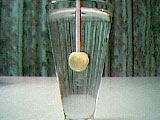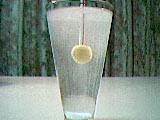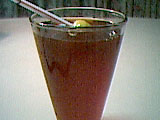


|
Density meter
Science at Home |
||
|
Materials
|
Compounds
|
Videos:
download2.avi (159 KB) Oil download3.avi (163 KB) Honey Pictures: 



|
|
Procedure
1. Fill about three forth of the two glasses total volume with water. 2. Fill with the same volume the other two glasses with honey and kitchen oil. 3. Add salt in one of the glasses with water and dissolve it. Stop adding salt when is reached a saturated solution. (the solution is saturated when there is deposit of salt in the bottom of the glass) 4. Make a bread ball with 2 cm diameter. 5. Stick the bread ball in one of the straw extremities. 6. Dive your density meter in the water without salt and mark the water level with a line. The mark will be used as reference. 7. Now, dive your meter in the water with salt. The line is above or below the water level without salt? Having salt, is it the same? 8. Dive the meter in the kitchen oil. What do you see? 9. Finally, dive the meter in honey. What happens now? |
||
|
Why?
The meter that you have just done calls aerometer. This experiment, as well as others, demonstrates that the liquids have different densities. The density is defined as the mass of a substance by volume unit. In the present experiment, ordering the liquids by an increasing density we have: Oil, water, water with salt and honey. For the obtained results we can conclude that the oil contains less mass per volume unit than water, water with salt and honey.
|
||
 |
No part of this website can be reproduced without previous authorization. Please inform me if there is any problem with the website. |